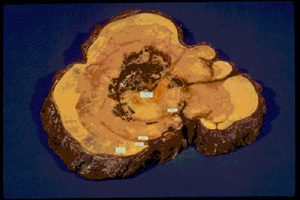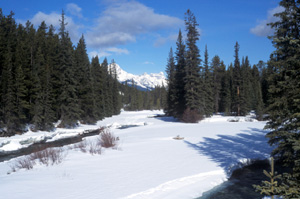|

Stories About Canada's Natural HeritageNovember 20, 2006 The fire detectives Printable version (119 KB) Investigating the history of fire in Banff National Park of CanadaThe managers of Banff National Park of Canada had an ambitious mission: to unravel the history of fire in the park. Why is fire history so important? Parks Canada wants to restore the the role of fire in modifying the vegetation communities of Banff. But what does this mean in practice? Examining the scars
Ian Pengelly is a fire and vegetation manager in Banff. He and his colleagues needed to "piece together the role of fire from different angles," says Ian. They selected trees to look for fire scars. A fire can leave a scar in the tree's annual growth ring. By examining the trees' rings, researchers can determine the year when the fire occurred. By comparing ring patterns among trees and stands the researchers obtained fire data going back some 800 years. The result, says Ian, was "likely some of the most detailed fire history mapping anywhere." They found very frequent fires in Banff up to the mid-1700s. Fires were still relatively common until about 1910, when they became much less frequent. What caused the big changes in the 1700s and 1900s?
Using weather records since the 1880s for Banff, researchers documented trends in temperature and precipitation. Comparing the tree ring analysis with the weather data, they could correlate tree growth with temperature and precipitation. This provided a measure of historic weather patterns, going back hundreds of years. They found no sharp changes in weather in the 1700s or 1900s to correspond with the changes in fire frequency. Was lightning involved?Lightning detector devices installed in the Rockies in the 1980s showed that Banff has little lightning fire activity compared with many other areas. So the lightning didn't explain the fire patterns either. All of this seemed to rule out natural agents as major determining factors in the fire pattern. The focus shifted to humans. Might human use of the landscape relate to fire patterns?
Archaeological records showed where aboriginal people lived before European settlement. These proved to be the areas where fires most frequently occurred. The evidence made sense. Early explorers had documented native people using burning to hunt game and provide dry wood for winter. In the European settlement period, accidental fires associated with towns and railroads were also relatively frequent. Then in the past century, fire was suppressed in the park. This led to changes in the landscape, as forests spread into grassland areas. A continuing role for fireClearly the fire situation is a complex one. However, one conclusion was inescapable. Historically fire was part of the landscape. It restored grasslands and maintained the plant communities that herbivores and omnivores depend on. For Ian Pengelly, this means that Parks Canada should keep fire in the parks except where public safety, park facilities and neighbouring lands are at risk. It means letting lightning fires burn. And it means carrying out prescribed burns to maintain a pattern of fire frequency similar to historic trends. Note: To read the PDF version you need Adobe Acrobat Reader on your system. If the Adobe download site is not accessible to you, you can download Acrobat Reader from an accessible page. If you choose not to use Acrobat Reader you can have the PDF file converted to HTML or ASCII text by using one of the conversion services offered by Adobe. 
|
|||||||||
|
||||||||




